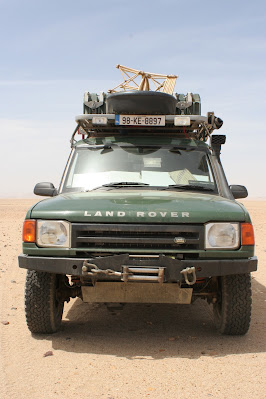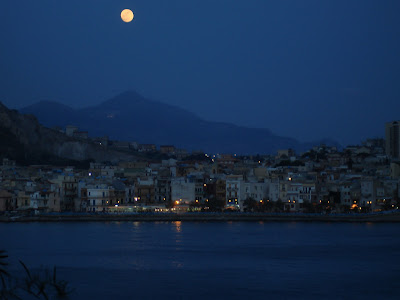Sahara Travels
Tuesday 8 April 2008
Wednesday 16 May 2007
Land Rover for Sale
16 Countries - 98 Days - 14,823 Miles - 23,855 Km - Cheapest fuel €0.15 (Alg) - Dearest fuel €1.16 (Italy) - 1 Puncture - 3kg Lighter - 1455 Photographs - 50˚C (Agadez, Niger) - 5 days, longest stop (Agadez again)
My highlights were
- First encounter with real desert in Mauritania
- All of Mali - the baobabs, the music clubs of Bamako, and especially the Dogon region and the river trip to Niafounké
- The mountains and deserts in Southern Algeria
The most enjoyable aspect of the journey was the people, especially away from the tourist centres of Morocco and Tunisia. Not a day passed without an interesting encounter.
Travelling overland, it is striking how quickly you can move from the rich world to the poor. Taking the UN Human Development Index as a guide we moved from Ireland (4th highest) to Spain (19); then - just eight miles over the Gibraltar Strait - to Morocco (123), Mauritania (153), Mali (175) and Niger (177), the poorest country of all by UN rankings.
Yet, despite all the problems of climate, poor government, and the daily struggle for survival, these are safe and fascinating places to visit. Well organised tourism, such as we experienced in the Dogon and southern Algeria, is one way to make a direct contribution to their development, in my opinion.
Anyway, this is the last post, and a big Thank You to everyone who wrote to say you enjoyed reading and travelled in spirit, it was great to get your emails and comments. And appreciation to my co-drivers Stefanie, Jason and Con for sharing the journey.
Now, if you know anyone interested in buying a well-tested Land Rover, you know where to look!
Thursday 10 May 2007
Toumani Diabate
Great Hostels of Italy
At the moment I am slowly travelling homeward via Italy, Switzerland, Germany, Belgium and France. The ferry is booked for Cherbourg-Rosslare and I'll be back in Ireland on May 14th.
The hostel manager recommended her friend's restaurant ("13 Gobbi") in another even more beautiful village nearby, Montefollonico. Fine local food - a thick Tuscan soup of beans and bread, roast duck with mushrooms served with fried pumpkin flowers stuffed with anchovies and mozzarella, panna cotta with wild berries; a big jug of Nobile, the local red, and a bottle of mineral water - all for €20.
Tuscan Sky
The north of Italy seemed crowded and dull compared to the South, and I stuck to the autostrade until diverting again to slow roads for the area around Lake Como and into Switzerland at Lugano. The Land Rover looks very alien amid all the shiny Porsche Cayennes and convertibles.
Over the St Gottard Pass (above) and onwards to Bern and the German border. No problems there, but French Customs was another matter. I'd gone over the Rhine to get a fill of diesel, as it is a bit cheaper there, and on the way back I got a long interrogation from four officers and the most detailed search of the whole trip. So much for the European single market, you'd think the Customs would be better off defending the external borders.
Tuesday 8 May 2007
The Indispensables
Ten things I’m glad I had in the Sahara...
- Anti-septic spray. Lived on the dashboard and used every day for hand-cleaning, cuts, grazes, bites.
- 230 litres of fuel capacity in fuel tanks and jerries. Made it possible to cover the long distances between fuel sources in Algeria, and saved money too.
- Water Tank. Great having 70 litres on board, enough for several days of camping and even an occasional shower.
- Air compressor. With the weight of the car it was essential to let down the tyre pressures on sand, sometimes several times a day. And I’d hate to have to use a hand pump.
- Fridge. After a day of heat and dust, nothing better than a cold beer.
- Swarfega heavy duty wipes. Perfect for cleaning up after car repairs, and saved on water.
- USB compatible radio. Allowed me to put over 100 albums on USB chips and they handled the bumps and dust without problems. So, never bored with the music, but can´t say the same for my co-drivers.
- Postcards of Irish Farm Animals. North Africans know how to appreciate a fat cow or shaggy sheep.
- Side Awning. Used just about every day, very quick to pull out for instant shade.
- Percolator. No excuse not to have a decent coffee.
And ten things I carried but could have done without.
- Winch. Never used it. Always quicker to use hands or shovel and mats if stuck in sand.
- Solar powered battery charger. The idea is to recharge the main battery by solar power if both batteries fail. I can only imagine it being needed on a very remote piste with no other traffic, and I would never go on such a piste without a companion vehicle.
- Firewood and fire lighters. It is recommended to bring firewood from home to avoid depleting local stocks. But we cooked on gas and rarely lit a fire until Algeria, where there seemed to be plenty of dead wood. And firelighters are not required when there is bone dry tinder at hand.
- Siphon tube. For transferring fuel, used once only.
- Tent. The free standing tent was never used. We had the roof tent, or slept out on the ground, sometimes with mosquito net.
- Second spare tyre. Maybe we were lucky, but we had no punctures until the last week in the desert, and that was a slow puncture that lasted til town. The tyres were new and good quality (BFGoodrich) and I would have done with just one spare.
- 12V inverter. Allows 220V plugs to work from car power system. Tried two, both failed quickly. Better to use 12V connectors for cameras and phones, and save the laptop for hotels.
- Solar shower. This is black bag that absorbs sun heat. Used once only, afterwards much happier to have a cooling shower.
- Side awning walls. These zip around the side awning to make a room with shelter from the wind, but only ever used them a couple of times.
- Spare set of springs. The four springs were heavy and bulky, could have risked not taking them.
I can’t think of much that I should have had but didn’t. Spare clutch plate I suppose!
Sunday 6 May 2007
Sicily
Moon Rise Over Palermo
A torrential downpour delayed Stefanie's flight and filled the streets of Palermo with water. On the first night we stayed at a B&B in Cinisi, close to the airport. The prices are a nice surprise - an excellent pizza at €5, coffee is 70c, cappuciono is €1 - why are we paying €2-3 in Ireland? The best luxury of all is the icecream, and it might be a Sicilian thing, but you can have it served in a brioche or sweet bun. Worth trying - once.
We spent the next couple of nights near the slopes of Mt Etna, which kindly provided a spectacular eruption one night - apparently there had been several already in April. We drove close enough to hear the explosions and could clearly see the flow of lava.
The Trikeles B&B in Giardini Naxos was very good, but hard to find, and the owner had to come and show us the way. €40 included a big breakfast buffet with fruit juices and cold meats. Unfortunately he was full the next night and we moved to the Hotel Astoria in the hilltop town of Taormina - old fashioned and well located, but with the grumpiest owner ever. We were constantly made to feel as if we'd run over their dog on arrival.
Friday 4 May 2007
Into Tunisia
This blog is the diary of a journey through the Sahara undertaken February-May 2007. The most recent post is first.
-
After our breakdown adventure near Timbuktu the rest of the journey to Gao was uneventful. It was a beautiful desert drive, sometimes on the...
-
This blog is the diary of a journey through the Sahara undertaken February-May 2007. The most recent post is first.
-
The Algerian border post - we camped on their football pitch Lots of this en route Con and Haakon are wondering how this chap was changi...















